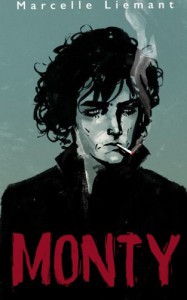Rod Raglin
This blog will touch on the experiences I have as a writer (not to be mistaken for my experience as a writer, i.e. how many books I've written, etc); the pleasure and the pain, the joy and the grief, the satisfaction and the frustration, the magic and the reality - have I left anything out, oh yeah, the rejection, rejection and more rejection, the humiliation and the embarrassment, the jealousy and the resentment - that pretty much covers it, except for why I do it which perhaps I'll realize along the way. Are you totally confused? Good, let's begin.
“Monty” gets a pass for effort, but fails in everything else

I want to thank Marcelle Liemant for his hard work and commitment to this worthwhile endeavor.
Monty, Nadia and Art are heading out on the town, but first they watch a house burn down. Then they’re off,
The streets rush past as we leap through the yellow lights. We run too fast, we laugh too loudly. We are too young and too old and too much. This night is open for the taking and we are rushing for it.
Monty apparently is emotionally damaged. Just what has happened isn’t clear. He wants to forget, to not inhabit his “self”, be filled with the presence of other people and events.
They crash a party, they drink whiskey, Monty dances wildly by himself to very loud music and becomes so caught up in it he does a handstand.
Another friend, Daria arrives at the party but they quickly have to leave. The four of them run through the streets (again). Nadia encourages Monty to go with Daria. She thinks Daria will help him recover from whatever is tormenting him.
The reader eventually learns what has traumatized Monty and pushed him to the brink is nothing more than being dumped by his previous girlfriend, Cecilia. As the wild night progresses “the thread” eventually takes him back to Cecilia’s where he attempts to purge the past that’s plaguing him by setting fire to where she lives.
.
Author Marcelle Liemant should be commended for his attempt at a progressive style of writing. His oblique dialogue, his somewhat unique phrasing and word pairings are interesting when they work, but most often they don’t. The vague references and ambiguity of the characters and their motivations quickly becomes frustrating.
More often than not conversations between characters are little more than existential gobbledygook. After a while this fifties-era hipster jive talk style became annoyingly pretentious as well as unnatural.
While Liemant may well have thought he was imbuing hidden meaning in the obscure imaginings and dialogue of his characters, to this reader it was just the opposite. What was likely meant to astound, instead confused
There’s a book by author and teacher Les Edgerton, called Finding your voice – how to put personality in your writing. In it Edgerton argues if you were allowed to just write “naturally”, not like how you were told to write and not like how you think a “writer” should write (which he calls writing “writer-ly”), you’d have your original voice.
In “Monty”, I get the impression the author is trying to copy the style of a writer he admires and it’s coming off sounding “writer-ly”. Copying someone else’s style usually tends to sound unnatural because, well, it is unnatural, not only for the obvious reason, but also because you’re likely not of his time, his place, and most certainly not of his presence of mind.
I believe if you have a good story the voice to tell it with will come to you. Sort of like the literary version of W. P. Kinsella’s famous line in “Field of Dreams”.
If you take away Monty’s angst, there’s no depth in his character whatsoever and neither is there in any of the other characters. By their actions and emotional responses I had the impression I was reading about adolescents, though their histories suggest they’re young adults.
The plot is superficial and only once and very briefly when Monty’s gender was questioned did I think there might be something more to it then post relationship antipathy and remorse.
There wasn’t.
I liked “Monty”, but only for what it attempted, not what it achieved.
I downloaded this book from StoryCartel free in exchange for an honest review and as part of my ongoing commitment to review the work of self-published authors.
30
SPECIAL PRE-0RDER PRICE NOW AVAILABLE
Saving Spirit Bear – 99¢ if ordered before November 8, 2015
Loving the Terrorist – 99¢ Beyond Eagleridge Bluffs
– order before December 6, 2015
After pre-order dates regular price will apply $2.99
To pre-order go to
http://www. amazon.com/author/rodraglin
Nominate The Widower,
my new novel on Kindle Scout
https://kindlescout.amazon.com/p/25MD9OLX9C88T
Video book reviews of self-published authors now at
Not Your Family, Not Your Friend Video Book Reviews: https://www.youtube.com/channel/UCH45n8K4BVmT248LBTpfARQ
Cover Art of books by self-published authors at
https://www.pinterest.com/rod_raglin/rod-raglins-reviews-cover-art/
My new novels, FOREST – Love, Loss, Legend and The BIG PICTURE – A Camera, A Young Woman, An Uncompromising Ethic are available on Amazon http://www.amazon.com/-/e/B003DS6LEU and as e-books at https://www.smashwords.com/profile/view/raglin
Read Reviews https://readersfavorite.com:book-review:39014
Visit my publisher’s website for excerpts from, and a buy link to my Eco-Fi series ECO-WARRIORS Book 3, Not Wonder More – Mad Maggie and the Mystery of the Ancients http://www.devinedestinies.com/?route=product%2Fauthor&author_id=92
ECO-WARRIOR Book 1, Saving Spirit Bear is available at
http://www.amazon.com/-/e/B003DS6LEU
ECO-WARRIOR Book 2, Loving the Terrorist - Beyond Eagleridge Bluffs is now available as in paperback at
http://www.amazon.com/author/rodraglin
More of my original photographs can be viewed, purchased, and shipped to you as GREETING CARDS; matted, laminated, mounted, framed, or canvas PRINTS; and POSTERS. Go to: http://www.redbubble.com/people/rodraglin
View my flickr photostream at https://www.flickr.com/photos/78791029@N04/
Or, My YouTube channel if you prefer photo videos accompanied by classical music
https://www.youtube.com/channel/UCsQVBxJZ7eXkvZmxCm2wRYA
 1
1
 monty
monty


